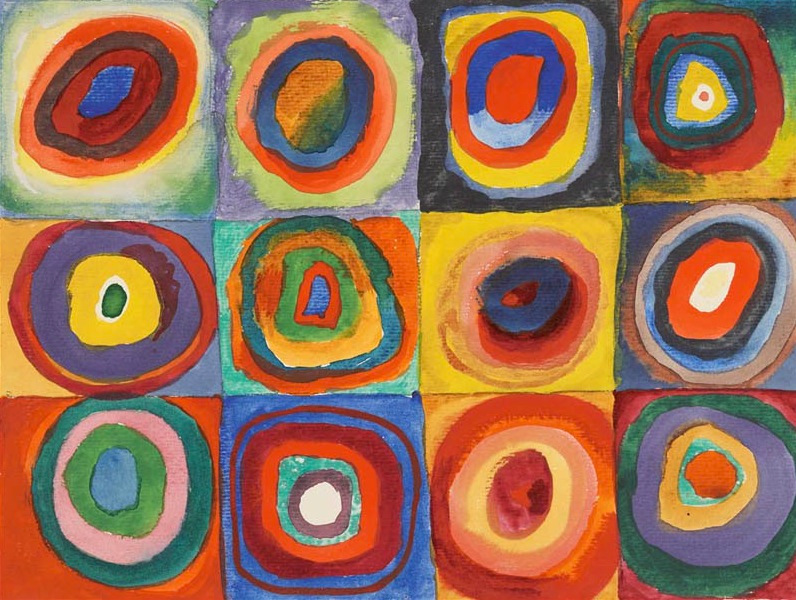Wassily Kandinksy (1866-1944) is an interesting character in art history. When I think of abstract art, the artists that first come to mind are Pablo Picasso, Paul Klee, and Piet Mondrian, but Kandinsky is actually considered the founder of abstract art, and is credited with creating the first piece of purely abstract art.
Kandinksy was born in Moscow, graduated from Grekov Odessa Art School, and then studied law and economics at the University of Moscow. Although a successful lawyer, Kandinsky began painting studies at the age of 30. He moved to Germany in 1920 and taught art at the Bauhaus school of art and architecture until it was closed by the Nazis in 1933. At that time he moved to France, and there he produced some of his most prominent art.
He was always fascinated by color and was greatly influenced by music, even comparing painting to composing music. The impressionist paintings of Monet inspired him, as did the music of Richard Wagner. Kandinsky started out painting landscapes, and it was rare that his paintings had human figures in them. He often chose fanciful rather than realistic colors, and his work was trending towards abstraction even at this early point in his career.
 |
| Munich-Schwabing with the Church of St. Ursula, 1908 |
I applied streaks and blobs of color onto the canvas with a palette knife and I made them sing with all the intensity I could . . . ~Wassily Kandinsky
From 1911 on, Kandinsky's paintings were large, expressive, and colorful, and even more abstract. He used musical terms like "improvisation" and "composition" in the titles of his paintings. He was also an art theorist, and taught both basic design and advanced theory at the Bauhaus. Geometrical elements became more prominent in his work, at least until 1934 or so, when he had moved to Paris and began using more non-geometric outlines and giving his paintings a more rustic feel.
 |
| The Rider, 1911 |
For Kandinsky, the link between music and art was very real. He wrote that "music is the ultimate teacher" and he said he heard tones and chords as he painted.
Colour is the key. The eye is the hammer. The soul is the piano with its many chords. The artist is the hand that, by touching this or that key, sets the soul vibrating automatically. ~Wassily Kandinsky
 |
| Composition VI, 1913 |
 |
| Brown with supplement, 1935 |
One of the most famous of Kandinsky's works is Farbstudie Quadrate, or Squares with Concentric Circles. This study of colors is the inspiration for the first lesson Kennady tried in ArtAchieve Level III, which we are reviewing soon. This ArtAchieve lesson uses a study of Kandinsky to explore color mixing.
 |
| Squares with Concentric Circles, 1913 |
Here is Kennady's imitation of Kandinsky's work, which will be featured on the Virtual Fridge soon. I'm not sure what kind of music she listened to while working, but I don't think it was Kandinsky's choice of Wagner!
 |
| Kandinsky Color Mixing by KAT, March 2017 |
For other ideas on Kandinsky inspired art projects for your homeschool, visit A Faithful Attempt and Arte a Scuola. I think those landscapes in Kandinsky's style look like fun!
Can you sense music as you look at some of these paintings? And do you visualize shapes and colors as you listen to music? You can view many of Kandinsky's paintings and find out more about him at Wassily Kandinsky - Biography, Paintings, and Quotes. I think Composition X is my favorite - which of his paintings do you like best? Leave a comment and let me know!
This post is linked at Blogging Through the Alphabet hosted by A Net In Time and Hopkins Homeschool. Join in to see what others are sharing related to this week's letter!
Can you sense music as you look at some of these paintings? And do you visualize shapes and colors as you listen to music? You can view many of Kandinsky's paintings and find out more about him at Wassily Kandinsky - Biography, Paintings, and Quotes. I think Composition X is my favorite - which of his paintings do you like best? Leave a comment and let me know!
This post is linked at Blogging Through the Alphabet hosted by A Net In Time and Hopkins Homeschool. Join in to see what others are sharing related to this week's letter!
©2006-2017 Homeschool Coffee Break. All rights reserved. All text, photographs, artwork, and other content may not be reproduced or transmitted in any form without the written consent of the author. http://kympossibleblog.blogspot.com/







































5 comments:
we learned a bit about Kadinsky in my latest art class for co-op, the kids had a lot of fun interpreting his work.
I hadn't heard of him before. Thank you for sharing, Kym!
I like the colors in those concentric circles :)
I like Kennady's Squares with Concentric Circles better than Kandinski's! Ha ha!
Thank you for introducing us to him. I hadn't heard of him, but find him particularly interesting because I have a daughter who is also a musician and an artist. She sings professionally with her daddy and sells her portraits.
I'm also looking forward to your review on Art Achieve, since it is recommended by SimplyCharlotteMason.com.
Have a blessed Easter!
You first introduced you first introduced me to Kandinsky through The Virtual Refrigerator. We had fun trying the concentric circles following his style.
Post a Comment
I love comments! It's like visiting over a virtual cup of coffee.